main: May 2010 Archives
Desmond has been in my thoughts today, back to the weeks before his death of lung cancer in 1977 at the age of 52. We talked frequently during that time. Here are two excerpts from Take Five: The Public and Private Lives of Paul Desmond, then a song that Paul cherished. He and Dave Brubeck played it together nearly from the beginning of their partnership.
A few days before Memorial Day, I got a call in San Antonio. "Hi, it's me, Desmond," he began, cheery as ever. After a few minutes we faded into an unusual conversational impasse, a series of commonplace exchanges that reflected what he knew and I suspected. He suggested that we both get mildly bombed on Friday evening and he would call me from Elaine's.Jenna had planned a trip to London for late May. Desmond encouraged her to take it. (Steve) Forster was looking after him, helping him get through the days. There was little that doctors could do.
"I was just falling to bits," Jenna said. "I needed to go away. The day before I left, I went to say goodbye and, frail as he was, he insisted that Steve take him downstairs to the camera shop to buy me one of those Polaroid instant things that had just come out. I got to London and, of course, rang him immediately, and he sounded reasonably good. We had a nice chat. I said I would talk to him the next day. And he said, 'No, no, don't call tomorrow. Ring me Tuesday.' I've got friends coming tomorrow, and I want you to relax and enjoy yourself.'"
"When I left on Friday," Forster said, "I kind of knew that would be the last time I would see him. I felt it, but I wasn't sure and, in a way, I didn't want to admit it. But...he was tired. He knew."On May 30, Memorial Day, Desmond's cleaning woman was unable to wake him.
Jack Richardson recalled that Marian McPartland said what many of Desmond's friends were thinking, "It's just like Paul to slip quietly away when everyone's out of town, not to bother anybody."
Occasionally, the Rifftides staff trolls the archives with an eye for older posts that hold up. Here is one from three years ago this Memorial Day weekend.
Time out of the writing crunch to hear successive Jessica Williams concerts was time well spent. Williams has taken a liking to The Seasons and returned there with her new trio for two evenings. On Saturday,Williams, bassist Doug Miller and drummer John Bishop played a Duke Ellington program. The repertoire, except for the infrequently heard calypso "Angelique," was made up of sixteen of Ellington's most familiar pieces. She opened with "C-Jam Blues," closed with "Take the 'A' Train" and included "I Got it Bad," "Do Nothing 'Til You Hear From Me," "Satin Doll" and...well, you get the idea. A routine Ellington lineup, perhaps, but Williams' piano playing and her interaction with Miller and Bishop were far from routine.
Williams employed all of her virtuosity; the improbably long fingers executing piston keystrokes, the extended crossed hands passages, the stride left hand, the tremolos, the polytonality. Still, what captured the crowd was the swing, warmth and humanity of the music. Following a distracted start on "Prelude to a Kiss," Williams called a halt and got sympathetic chuckles from the audience when she said, "If you can forgive others, you can forgive yourself." She started the song again, soloed with passion and comped like a guiding angel behind a Miller bass solo that was a highlight of the concert. Williams' concept for the evening was to program it as if the trio were playing for a dance. Indeed, she encouraged people to dance in the area between the front row of seats and the stage. Three couples did, rather tentatively, during "Mood Indigo," but one of them told me later that the listening was so good, dancing was a distraction. That's an interesting switch on the old complaint "Why don't you play something we can dance to?"
Sunday, Memorial Day eve, Williams premiered a new composition, "Freedom Suite," not related to the 1958 Sonny Rollins piece with the same name. She dedicated the six-movement work to veterans who died in all US wars from the American Revolution to Iraq and Afghanistan. Prefaced with a flag ceremony by women volunteers from a Veterans of Foreign Wars unit, the suite began with an other-worldly piano introduction to Miller's bowing of "Taps," its resonance supported by Williams' impressionistic chords and the shimmering swell of Bishop's cymbals. The movement called "Night Patrol" surged with modal intensity through piano and bass solos into a Bishop drum solo over an insistent pedal point.
Introducing the "Final Wish" section, Williams said, "I finished writing this one at 3:30 or 4:00 o'clock this morning. I wanted it to be perfect--and so far, it is." She showed Bishop the bass part she had written for Miller, explaining the varied rhythms she wanted through a series of eight-bar sections. Bishop nodded and smiled, and with only that discussion for a rehearsal, the trio played the piece for the first time. It remained perfect.
Leaning into the piano, Williams stroked the strings like a harpist, setting up insistent three-four time that supported the dirge of the final movement, "Lament." By way of her virtuosity through an unaccompanied solo that at times suggested an affinity for early McCoy Tyner, she managed to express optimism as well as sadness before Miller and Bishop rejoined her for a final statement of the theme.
This is an initial impression of a work I want to absorb further. We may all have that opportunity. The concert was recorded and could appear on a CD. If that happens, I'll let you know.
So far, it hasn't happened. Stay tuned.
Keith Jarrett/Charlie Haden, Jasmine (ECM). Keith Jarrett has had partnerships with powerful and distinctively different bassists; Gary Peacock since 1983 in the pianist's Standards Trio; Palle Danielsson in the late 1970s in Jarrett's European Quartet; Charlie  Haden in his mid-70s quartet. For all of Peacock's dazzling virtuosity and Danielsson's rock-solid strength, Haden brought to Jarrett's music something unique—deceptive simplicity rooted in his beginnings as a folk musician. Rather than the parsing of chords that dominates much of modern jazz bass playing, Haden's lines relate directly to melodies. Often, his bass lines are less accompaniments or harmonic guides than melodies or melodic variations offered as commentaries. That might drive some pianists to distraction, but not Alan Broadbent of Haden's Quartet West, and not Jarrett.
Haden in his mid-70s quartet. For all of Peacock's dazzling virtuosity and Danielsson's rock-solid strength, Haden brought to Jarrett's music something unique—deceptive simplicity rooted in his beginnings as a folk musician. Rather than the parsing of chords that dominates much of modern jazz bass playing, Haden's lines relate directly to melodies. Often, his bass lines are less accompaniments or harmonic guides than melodies or melodic variations offered as commentaries. That might drive some pianists to distraction, but not Alan Broadbent of Haden's Quartet West, and not Jarrett.
Thirty-three years after they last recorded together, the empathy between Jarrett and Haden retains its seductive strength in this collection of ballads. Haden's deliberative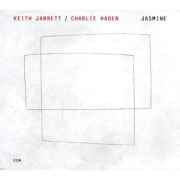 playing underscores the beauty of "For All We Know," "Goodbye," "Where Would I Go Without You?" and other slow pieces. When the tempo increases slightly on "Body and Soul" and prominently on "No Moon At All," he generates amiable forward motion, a runner on a relaxed jog finding the perfect slot . A pleasing aspect of Haden's work has long been his ability to solo by creating melodies that approximate story-telling speech. There are instances of that on nearly every track here, notably in "Body and Soul."
playing underscores the beauty of "For All We Know," "Goodbye," "Where Would I Go Without You?" and other slow pieces. When the tempo increases slightly on "Body and Soul" and prominently on "No Moon At All," he generates amiable forward motion, a runner on a relaxed jog finding the perfect slot . A pleasing aspect of Haden's work has long been his ability to solo by creating melodies that approximate story-telling speech. There are instances of that on nearly every track here, notably in "Body and Soul."
Jarrett's lyricism seems stirred by Haden's careful listening and note choices. He creates memorable solos throughout. There is fugue-like independence of left- and right-hand lines in his stimulating work in "No Moon At All." He caresses the melody of Victor Young's "Where Would I Go Without You," then in his solo finds the blues implications in the tune's harmonies. Following an unaccompanied introduction to "I'm Gonna Laugh You Right Out of My Life," he manages to be languorous and urgent at the same time. In the bridge of the second chorus of his solo on "Body and Soul," he achieves a floating state approaching weightlessness. Jasmine is a satisfying addition to Jarrett's discography.
Coming soon on Rifftides, a review of ECM's retrospective release of early recordings by Jarrett's Standards Trio, Steve Kuhn, Gary Burton with Chick Corea, and Eberhard Weber.
On a collection of horns that amounts to an instrument museum, Scott Robinson plays every style of jazz from traditional to free. One night he might be with the cornetist Jon- Erik Kelso playing music inspired by Bix Beiderbecke, the next anchoring the floating impressionism of Maria Schneider's orchestra. His arsenal, dozens of instruments, ranges from the slide soprano sax to the contrabass saxophone. It includes the theremin, the normaphone and the bass marimba. He plays all of those and more, and plays them well. In a video attached to the online version of Will Friedwald's portrait of Robinson in the Wall Street Journal, he demonstrates a few of his prized possessions. To read the article and see the clip, go here.
Erik Kelso playing music inspired by Bix Beiderbecke, the next anchoring the floating impressionism of Maria Schneider's orchestra. His arsenal, dozens of instruments, ranges from the slide soprano sax to the contrabass saxophone. It includes the theremin, the normaphone and the bass marimba. He plays all of those and more, and plays them well. In a video attached to the online version of Will Friedwald's portrait of Robinson in the Wall Street Journal, he demonstrates a few of his prized possessions. To read the article and see the clip, go here.
In Friedwald's piece, Robinson mentions his love of the tenor saxophone, which he considers his main horn. Here he is, playing tenor last year with the amazing 87-year-old Frank Wess on the Gene Ammons-Sonny Stitt specialty "Blues Up And Down." The rhythm section is Ilya Lushtak, guitar; Tal Ronen, bass; and Quincy Davis, drums. Robinson is the one on the right, in the conservative jacket.
Back off the road and facing deadlines, I'm still in a blogging-lite mode.
We were in Seattle to see the world premiere of Daron Hagen's opera Amelia. The final performance was Saturday night, but this grand fugue of an opera is too good not to have further productions. Following the Seattle Opera's sensational unveiling, other companies are bidding for it. If it shows up within walking,  driving or flying distance, I strongly urge you to put it on your calendar. The superb Seattle cast was headed by the young mezzo soprano Kate Lindsey (pictured), who is bound to become an international star. Composer Hagen's music, conducted by the Seattle Symphony's Gerard Schwartz, is tonal, modern and powerful. The orchestral portions, so essential to the production, deserve to be fashioned into a suite. Hagen, librettist Gardner McFall and stage director Stephen Wadsworth layered a complexity of themes into a counterpoint of death, loss, birth and the joy of life .
driving or flying distance, I strongly urge you to put it on your calendar. The superb Seattle cast was headed by the young mezzo soprano Kate Lindsey (pictured), who is bound to become an international star. Composer Hagen's music, conducted by the Seattle Symphony's Gerard Schwartz, is tonal, modern and powerful. The orchestral portions, so essential to the production, deserve to be fashioned into a suite. Hagen, librettist Gardner McFall and stage director Stephen Wadsworth layered a complexity of themes into a counterpoint of death, loss, birth and the joy of life .
The story uses the gratification, challenges and dangers of flight as a metaphor for the human condition. Based on McFall's poetry and her own experience, the main thread is a daughter's longing for her father, a Navy pilot who was killed in Viet Nam when she was a girl. Now grown, she is about to give birth. Nearly a basket case, she is obsessed by flight to the point where, in a classic mad scene, she attempts to stop a secret aircraft design project headed by her engineer husband. Other fliers who were lost decades and centuries before—Amelia Earhart and Daedalus—appear in brilliant set design by Thomas Lynch and staging by Wadsworth that weave history, myth and events of our time into a kaleidoscope of conflicting emotions. The final scene in a hospital delivery room, with a glorious, not quite cacophonous, blending and interaction of nine voices, is a great moment in contemporary theatre. I wish that you could all have been there.
Here's a video designed as a preview. Without giving too much away, it also serves as a summary. If you think you don't like opera, this one could change your mind.
Broadcast tributes to Hank Jones continue. Jim Wilke of Public Radio International's Jazz After Hours alerts Rifftides that he is preparing two for this weekend. From the Jazz After Hours alert:
Jim remembers the rich legacy of pianist Hank Jones, who died last week at the age of 91. Hank Jones' career spanned over sixty years, from Jazz at the Phil with Coleman Hawkins, Charlie Parker, and others to the present decade; he was to play with Joe Lovano at Birdland next week. There will be two or three selections by Hank Jones in each hour of Jazz After Hours this weekend.
To find whether there is a Jazz After Hours station in your listening area, go here. If there is not, Wilke's home station, KPLU in Seattle, streams the show on the web from midnight to 5:00 AM PDT Saturday and Sunday. To tune it in, or whatever you call tuning in on the internet, go here.
I'm happy to send listeners to Jim, but in part this item was an excuse to use a wonderful picture that he sent with the message.
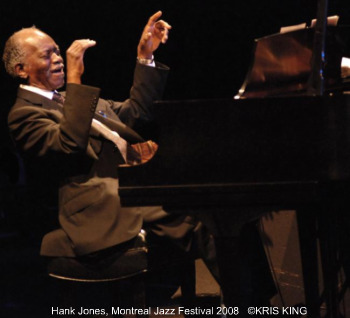
The counterpoint that Dave Brubeck and Paul Desmond generated in the early-to-mid 1950s leads many serious listeners to consider the period the creative height of their partnership. For all the success of their later work, including "Take Five," after the late fifties counterpoint was a less frequent, less concentrated part of their work. There were exceptions, even after the Brubeck quartet disbanded in 1969. One came during a brief stage when the temporarily reconstituted quartet featured Gerry Mulligan as the saxophonist. Desmond sometimes appeared with them. Thanks to Rifftides reader John Bolger for calling our attention to a video that recently popped up on the web. The year of recording is in dispute, but the latest information indicates that it was made in Holland during a 1972 Newport Jazz Festival tour. The tune is "All The Things You Are," a favorite in the repertoires of all three men. They frequently played it when Jack Six and Alan Dawson were the bassist and drummer with Brubeck, as they were that night.
During the course of Desmond's solo, the intensity of swing increases chorus by chorus and continues during Mulligan's and Brubeck's solos. Then, there's a chorus of counterpoint between Desmond and Brubeck, another between Mulligan and Brubeck and, finally, two choruses of the three constructing what comes very close to meeting the formal requirements of a fugue—exposition, subject, countersubject—the whole magilla. Six and Dawson beautifully support the operation. I should add that this is a prime demonstration by Brubeck of why Desmond prized him as an accompanist.
Extra added attraction: a clear look at The Suit, Desmond's favorite apparel during his final years. This video is a find.
The YouTube contributor who posted the video attached a note promising that there would be more from the concert upon request. Let's hope that he or she gets plenty of requests.
In The New York Times "City Room" blog, Corey Kilgannon and Andy Newman have a strange, poignant followup to the news of Hank Jones's death. No one who knew Hank will be surprised at the selflessness it portrays or be unmoved by its tale of loneliness.
He stayed active till the very end, collecting a Grammy last year and touring the world. But when he wasn't on the road, he lived in near isolation in a 12-by-12-foot room at 108th Street and Broadway, ordering in three meals a day from the diner downstairs and practicing incessantly on an electric keyboard plugged into headphones.
"He was worried he would bother the neighbors," said Mr. Jones's roommate and landlord, Manny Ramirez. "The neighbors would ask, 'Why don't we hear Hank anymore?' I said, 'He locks himself in his room all the time.'"
To read the whole thing, go here.
Deadlines and other obligations at Rifftides World Headquarters and elsewhere will keep me occupied for the next few days. Blogging will be as possible. In the meantime, the staff encourages you to browse five years worth of archive postings. Go here and scroll down. Be prepared to do a lot of scrolling. Who knows, you might find buried treasure. Here's a staff favorite.
for the next few days. Blogging will be as possible. In the meantime, the staff encourages you to browse five years worth of archive postings. Go here and scroll down. Be prepared to do a lot of scrolling. Who knows, you might find buried treasure. Here's a staff favorite.
The parade outward continues.
Hank Jones died last night in a New York hospital following a brief illness. He was 91. For a thorough obituary, see this piece by Peter Keepnews in The New York Times.
The last times I heard Mr. Jones, at the 2008 Lionel Hampton festival, his elegance, celebrated evenness of touch and full command of the piano were undiminished:
The ranking master of the evening was pianist Hank Jones, playing beautifully in his 90th year. His two-piano duet partners, sixty-odd years younger, were Gerald Clayton and Taylor Eigsti. Each of the three also played a solo piece. John Clayton joined him on bass and Jones performed "Satin Doll" with notable vigor...
His vigor never subsided, nor did his sensitivity or ability to move an audience, as in this recent Tokyo appearance.
I recommend Howard Mandel's Jazz Beyond Jazz posting about Mr. Jones. Go here.
A year-and-a-half ago, I wrote a piece about Al Cohn for The Note, the newsletter of The Al Cohn Memorial Jazz Collection at East Stroudsburg University in Pennsylvania. The school is a part of  the state system of higher education and of a jazz community that thrives in the Delaware Water Gap area of the Poconos Mountains 70 miles from New York City. The region's premier jazz club, The Deer Head Inn (pictured), has become known around the world because of recordings made there by Phil Woods, John Coates Jr. and Keith Jarrett. Among the many musicians who live in or near the gap are Liebman, Woods, Bob Dorough and Hal Galper. For years, Woods has written "Phil In The Gap," a witty lead column in The Note.
the state system of higher education and of a jazz community that thrives in the Delaware Water Gap area of the Poconos Mountains 70 miles from New York City. The region's premier jazz club, The Deer Head Inn (pictured), has become known around the world because of recordings made there by Phil Woods, John Coates Jr. and Keith Jarrett. Among the many musicians who live in or near the gap are Liebman, Woods, Bob Dorough and Hal Galper. For years, Woods has written "Phil In The Gap," a witty lead column in The Note.
Evidently, my Cohn article didn't drive away too many subscribers; Bob Bush, the editor, asked me write one about Zoot Sims. I did. It appears in the Spring 2010 issue of The Note. It begins:
Zoot Sims was wandering around in Eagleson Hall, across from the University of Washington campus in Seattle, looking lost. It was the spring of 1955."I heard there was going to be a blow," he said.
That was the first time I met Zoot and the first time I had heard a jam session called a blow. I steered him toward the auditorium. He was in town for a one-nighter, part of a package tour Norman Granz's brother Irving was taking up the west coast. The Chet Baker and Dave Brubeck quartets and George Shearing's quintet were on the bill with Zoot's group. Following the concert at a theatre downtown, several of the musicians went out to Eagleson to jam with a cross section of Seattle players. Sims, Baker, Shearing and Toots Thielemans showed up, greeted by a contingent of horn players eager to sit in with the visiting stars. Pianist Paul Neves headed up the rhythm section. At one point during the evening the festivities included the young bassist Freddie Schreiber, who later had a short, brilliant career with Cal Tjader.
Zoot installed himself on a stool near the piano and played until long after Baker, Shearing and the others bailed out. At three in the morning, it was Zoot and the rhythm section, then Zoot with bass and piano, then Zoot and Neves. Finally, the pianist left. While the drummer packed up, Zoot kept playing. It is an indelible image; Zoot with his eyes closed, head resting back against the wall, swinging by himself.

The article has tales of encounters with Zoot in New Orleans and New York, including this snippet:
When Zoot and Louise hopped on the train and came out to our place in Bronxville, the evenings were full of food, drink, good conversation and laughter. Ben Webster's recording of "All Too Soon" with Ellington was a requirement. "Play it again," Zoot would say. "I can't get enough of it." Late in his career, his sound took on more of Webster's amiable gruffness. One December, the Simses, Pepper Adams, my wife and I froze through a snowstorm and watched the Baltimore Colts' embarrass the New York Giants in Yankee Stadium. We thawed out with dinner and a few games of ping pong at Zoot's and Louise's apartment. With his timing and relaxed attack, Zoot put me away handily and gave Pepper a good run for his money.
The Note has no online edition, so I am unable to give you a link to the complete article. The Al Cohn Collection does have a web site. If you go to it and scroll down to "Publications," you will see how to get on the mailing list. The current issue has pieces by Dave Frishberg about Bob Newman, a former Woody Herman tenor saxophonist who was at the heart of the Poconos scene; and by the pianist Gene DiNovi about the great studio musicians Gene Orloff and Ray Beckenstein. Scroll to "How to Donate" and you will see a way to help the nonprofit Al Cohn Collection sustain The Note as well as maintain and expand an archive that is invaluable to scholars, researchers and writers.
ADDENDUM
Zoot Sims, tenor saxophone; Red Mitchell, bass; Rune Gustafsson, guitar.
Television was a long time coming to the little eastern Washington town where I grew up. As a boy, I listened to a lot of radio. It made pictures in my head. One of the pictures was of something called a Mighty Wurlitzer and the woman who played it. It seemed that the theme music or background of half the shows on the air were by Rosa Rio, whose name was all but synonymous with that gargantuan instrument. Ms. Rio died on Thursday, less than a month short of her 108th birthday.
She was born in New Orleans in 1902 and decided on a life in show business when she was a youngster. Upon hearing a Wurlitzer for the first time, she switched from piano to organ. In movie houses, she provided music for silent films, including this insane Buster Keaton sketch, revived at the Tampa Theatre after she allegedly retired to Florida but couldn't stop playing.
For an obituary of Rosa Rio, see this piece by Margalit Fox in The New York Times.
Devotees of medium-sized bands, some of which are discussed here and here* in the Rifftides archives, will enjoy Ed Leimbacher's new posting on his I Witness blog. His piece begins with a series of puns so bad that they're bad, but goes on to provide entertaining and useful information about groups led by Marty Paich and Nat Pierce. A brief sample:
I fully expected to find the Paich album superficial and the Pierce one to be more substantial... which should teach me to eschew preconceptions. Because Paich's pieces slink and soar, all but one tune his own originals, while Pierce's program mixes reworkings and his own tunes about equally (and more stolidly).
To read all of Leimbacher's illustrated essay, go here.
*Revisiting this, I see that I promised a third installment. That was two years ago. I'll put it back on the to-do list.
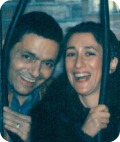 Marc Myers, the proprietor of Jazzwax, wrote an interesting Wall Street Journal article about widows of prominent jazz musicians. He focuses first on Laurie Pepper (pictured with her husband), who makes a business of maintaining Art Pepper's legacy. She has issued on her Widow's Choice label several previously unissued CDs of Pepper's music. Marc also covers Mrs. Dexter Gordon's, Mrs. Louis Bellson's and Mrs. Charles Mingus's activities in the years since their husbands' deaths.
Marc Myers, the proprietor of Jazzwax, wrote an interesting Wall Street Journal article about widows of prominent jazz musicians. He focuses first on Laurie Pepper (pictured with her husband), who makes a business of maintaining Art Pepper's legacy. She has issued on her Widow's Choice label several previously unissued CDs of Pepper's music. Marc also covers Mrs. Dexter Gordon's, Mrs. Louis Bellson's and Mrs. Charles Mingus's activities in the years since their husbands' deaths.
From the piece:
In the jazz world, Mrs. Pepper's efforts are the exception rather than the rule. Aside from Sue Mingus, Maxine Gordon, Francine Bellson and a handful of other enterprising widows, most spouses of deceased jazz greats fail to leverage their husbands' legacies.
"Without an advocate in the marketplace, the commercial value of a jazz artist's name slips away," says Peter Shukat, an entertainment lawyer with Shukat Arrow Hafer Weber & Herbsman in New York. The firm represents the estates of eight deceased entertainers, including John Coltrane, Charles Mingus and Nina Simone.To be fair, many older jazz widows do not have the energy, expertise or entrepreneurial skills to take on such a venture. "Others don't have the financial means or help from family members," says Mrs. Mingus. "Or they may have better things to do with their time."
To read the whole thing, go here.
In a message to the Jazz West Coast listserve, Linda Shank, whose alto saxophonist husband Bud died last year, responded to the Myers piece. With her permission, here is her comment:
Personally I don't want to play the eternal role of jazz widow. I own our music publishing company and handle that business with our CPA and lawyer, but all of Bud's product sales through his website I donated along with his massive archives and instruments to the Bud Shank Archive at the Los Angeles Jazz Institute. That way his huge history is available to students, scholars, and interested jazz fans. That would not be the case if I kept the materials in my closet. Being a widow is damned hard, and even harder when your husband is a famous artist. I just don't want to hear or think about Bud every day as it makes the pain that much worse. Widows should have a way to get on with their lives. I know a widow who has kept her husband's bass in the living room for more than twenty years! IMHO this is morbid to say the least. I had almost two splendid decades with Bud and we wrote some fine music together. I am grateful, and hope I can find a happy life ahead.
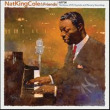 Nat King Cole & Friends, Riffin': The Decca, JATP, Keynote and Mercury Recordings (Hip-O Select). This three-CD box begins with 17 tracks of a trio that served as the model for groups led by Art Tatum, Oscar Peterson, Page Cavanaugh and too many others to list. Nat Cole became one of the most famous singers in the world, but his enduring impact on jazz was as a pianist whose example inspired Bud Powell, Peterson, Bill Evans and virtually every other modern pianist who developed in the 1940s and '50s. This is the original 1940-'41 Cole trio that included guitarist Oscar Moore and bassist Wesley Prince. The pieces include "Sweet Lorraine," "Gone With the Draft" and plenty of other vocals and, on every track, Cole's incomparably light and inventive piano solos. The rest of the impressively packaged album presents Cole the pianist in Jazz at the Philharmonic concerts with a variety of his contemporaries and in imperishable dates with Lester Young, Dexter Gordon and Willie Smith. There are also glimpses of the very young Cole in 1936 as an Earl Hines disciple.
Nat King Cole & Friends, Riffin': The Decca, JATP, Keynote and Mercury Recordings (Hip-O Select). This three-CD box begins with 17 tracks of a trio that served as the model for groups led by Art Tatum, Oscar Peterson, Page Cavanaugh and too many others to list. Nat Cole became one of the most famous singers in the world, but his enduring impact on jazz was as a pianist whose example inspired Bud Powell, Peterson, Bill Evans and virtually every other modern pianist who developed in the 1940s and '50s. This is the original 1940-'41 Cole trio that included guitarist Oscar Moore and bassist Wesley Prince. The pieces include "Sweet Lorraine," "Gone With the Draft" and plenty of other vocals and, on every track, Cole's incomparably light and inventive piano solos. The rest of the impressively packaged album presents Cole the pianist in Jazz at the Philharmonic concerts with a variety of his contemporaries and in imperishable dates with Lester Young, Dexter Gordon and Willie Smith. There are also glimpses of the very young Cole in 1936 as an Earl Hines disciple.
Emil Viklický, Live in Vienna (Cube-Metíer). Here we have the dean of Czech jazz pianists and his trio at a peak of inspiration and passion. Viklický, bassist Frantisek Uhlíř and drummer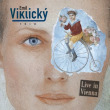 Laco Tropp long ago melded into one of the most empathetic working bands alive. At this 2007 concert, something—perhaps the vaunted Viennese appreciation of music—sparked added heat. The Viklický trio's Moravian zest has shone in previous recordings of "A Bird Flew Over," "Longing," and his trademark "Wine, Oh Wine." In Vienna, the intensity went up a notch, emphatically so in the powerful "Highlands, Lowlands." Like his Czech compatriot George Mraz, Uhlíř is in the top flight of contemporary bassists. He demonstrates his standing not only in the perfection of his sound and the demonic drive of his lines but also in solos like those on "Father's Blues" (bowed) and "Highlands, Lowlands" (plucked). It is unlikely that in a blindfold test anyone would peg Tropp's solo on "Wine, Oh Wine" as by an Eastern European drummer. An experienced listener might guess that it's Philly Joe Jones. As for Viklický, the pianist is at the top of his multifaceted game.
Laco Tropp long ago melded into one of the most empathetic working bands alive. At this 2007 concert, something—perhaps the vaunted Viennese appreciation of music—sparked added heat. The Viklický trio's Moravian zest has shone in previous recordings of "A Bird Flew Over," "Longing," and his trademark "Wine, Oh Wine." In Vienna, the intensity went up a notch, emphatically so in the powerful "Highlands, Lowlands." Like his Czech compatriot George Mraz, Uhlíř is in the top flight of contemporary bassists. He demonstrates his standing not only in the perfection of his sound and the demonic drive of his lines but also in solos like those on "Father's Blues" (bowed) and "Highlands, Lowlands" (plucked). It is unlikely that in a blindfold test anyone would peg Tropp's solo on "Wine, Oh Wine" as by an Eastern European drummer. An experienced listener might guess that it's Philly Joe Jones. As for Viklický, the pianist is at the top of his multifaceted game.
Peter Erskine, Chuck Berghofer, Terry Trotter, The Trio Live @ Charlie O's (Fuzzy Music) (MP3 or CD). Impromptu gigs can be unmitigated bores, fatal minefields or memorable encounters. In contrast to the Viklickýs, who are all but family, pianist Trotter, bassist Berghofer and drummer Erskine 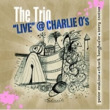 came together for one evening in a modest Los Angeles-area jazz club. They found their bond as premier working jazz musicians who know the idiom, the repertoire and the craft of listening and reacting. Simply put, everything worked. Good tunes provide the material, from the familiar Miles Davis arrangement of "Put Your Little Foot Right Out" to J.J. Johnson's ballad "Lament." John Lewis's rarely-played "Afternoon in Paris," Billy Strayhorn's "Blood Count," a langorous "Ghost of a Chance" and a long, satisfying treatment of "How Deep is the Ocean" complete the album. Trotter is less well known than Berghofer and Erskine, but musicians and the listening cognoscenti admire him for his flawless taste, even touch, harmonic command and spontaneous invention of the kinds of melodies that composers lie awake at night praying for.
came together for one evening in a modest Los Angeles-area jazz club. They found their bond as premier working jazz musicians who know the idiom, the repertoire and the craft of listening and reacting. Simply put, everything worked. Good tunes provide the material, from the familiar Miles Davis arrangement of "Put Your Little Foot Right Out" to J.J. Johnson's ballad "Lament." John Lewis's rarely-played "Afternoon in Paris," Billy Strayhorn's "Blood Count," a langorous "Ghost of a Chance" and a long, satisfying treatment of "How Deep is the Ocean" complete the album. Trotter is less well known than Berghofer and Erskine, but musicians and the listening cognoscenti admire him for his flawless taste, even touch, harmonic command and spontaneous invention of the kinds of melodies that composers lie awake at night praying for.
Marc Cary Focus Trio, Live 2009 (Motéma). Cary's lyricism alleviates a tendency toward McCoy Tyner density that over the course of several pieces can accumulate discomfiting weight. The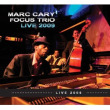 42-year-old pianist's third album with bassist David Ewell and drummer Sameer Gupta achieves reasonable balance between both aspects. The three have developed rapport that generates excitement in nearly every track, including a treatment of "'Round Midnight" founded on a bass ostinato that persists throughout. As elements of their message, "Runnin' Out of Time" and "Slow Blues for MLK" incorporate audio clips of Malcolm X and Martin Luther King, Jr. "Just in Time" is an all-out high-speed post-bop romp. In Jackie McLean's "Minor March," the trio eases out of a drum-heavy section into concluding passages in which Cary lightens his touch and executes fleet lines that levitate above the rhythm. It is a moment of relief from the power that characterizes most of the CD. It is fair to point out that the audiences at several concerts where the tracks were recorded make it known that they heartily approve that power and excitement.
42-year-old pianist's third album with bassist David Ewell and drummer Sameer Gupta achieves reasonable balance between both aspects. The three have developed rapport that generates excitement in nearly every track, including a treatment of "'Round Midnight" founded on a bass ostinato that persists throughout. As elements of their message, "Runnin' Out of Time" and "Slow Blues for MLK" incorporate audio clips of Malcolm X and Martin Luther King, Jr. "Just in Time" is an all-out high-speed post-bop romp. In Jackie McLean's "Minor March," the trio eases out of a drum-heavy section into concluding passages in which Cary lightens his touch and executes fleet lines that levitate above the rhythm. It is a moment of relief from the power that characterizes most of the CD. It is fair to point out that the audiences at several concerts where the tracks were recorded make it known that they heartily approve that power and excitement.
Lena Horne is being remembered with the respect and admiration that her talent and tenacity won her in decades of struggle and refusal to compromise. Her travails and triumphs are recounted in dozens of obituaries on the air, on web sites and in publications around the world. This one from The New York Times has the essential details of her remarkable life. The stories emphasize the prejudices she battled, the barriers she shattered and the major stardom as an actress that bigotry denied her. Understandably, the accounts concentrate more on the drama of her life than on the nature of her artistic gifts.
Ms. Horne was a first-class singer in all aspects of the craft. As I watched and heard her pour herself into the song in the video below, I thought of her telling how Billy Strayhorn, her closest friend, made of her not just a singer, but a musician. This was Lena Horne in 1967, when she was 50, a fine actress and a great singer.
Bill Carrothers, Joy Spring (Pirouet). Carrothers, a pianist, lives in a remote area of Michigan, has a quixotic web site and records copiously for European labels. A prodigious technician, he is a master of the  reassembled melody and the customized harmonic scheme. Here, he renovates pieces from the repertoire of the great trumpeter Clifford Brown. "Joy Spring," recognizable by a few of its phrases, is a slow meditation. "Jordu," becomes, improbably, a march. When he observes tempos and harmonies resembling those of Brown's recordings, Carrothers makes the pieces his own through ingenious chord transformations. "Daahoud," "Tiny Capers" and "Gherkin for Perkin" are among the subjects of his makeovers. Bassist Drew Gress and drummer Bill Stewart are Carrothers' co-conspirators in this stimulating set.
reassembled melody and the customized harmonic scheme. Here, he renovates pieces from the repertoire of the great trumpeter Clifford Brown. "Joy Spring," recognizable by a few of its phrases, is a slow meditation. "Jordu," becomes, improbably, a march. When he observes tempos and harmonies resembling those of Brown's recordings, Carrothers makes the pieces his own through ingenious chord transformations. "Daahoud," "Tiny Capers" and "Gherkin for Perkin" are among the subjects of his makeovers. Bassist Drew Gress and drummer Bill Stewart are Carrothers' co-conspirators in this stimulating set.
Dr. Lonnie Smith, Spiral (Palmetto). With never a thought of retooling tunes a la Carrothers, the maestro of the Hammond B3 organ nonetheless ventures well beyond conventional organ trio clichés. He continues to produce CDs whose swing and good feeling compel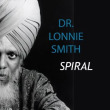 smiles and the rhythmic employment of pedal extremities. Smith is, however, considerably more than a party music organist, as he demonstrates with the moodiness and surprise chordal turns of his minor-key title tune, the rhythmic variety in "I Didn't Know What Time It Was" and the apiary atmospherics of his interpretation of Harold Mabern's "Beehive." His swing is irresistible in "I've Never Been in Love Before" his bluesiness profound in Slide Hampton's "Frame for the Blues." Guitarist Jonathan Kreisberg and drummer Jamire Williams are admirable in support. In his 68th year, the Dr. is in.
smiles and the rhythmic employment of pedal extremities. Smith is, however, considerably more than a party music organist, as he demonstrates with the moodiness and surprise chordal turns of his minor-key title tune, the rhythmic variety in "I Didn't Know What Time It Was" and the apiary atmospherics of his interpretation of Harold Mabern's "Beehive." His swing is irresistible in "I've Never Been in Love Before" his bluesiness profound in Slide Hampton's "Frame for the Blues." Guitarist Jonathan Kreisberg and drummer Jamire Williams are admirable in support. In his 68th year, the Dr. is in.
David Sills Light Touch (Dasil). Tenor saxophonist Sills takes his time, constructing thoughtful lines that tell stories. Even at brisk tempos, as in Charlie Parker's "Blues for Alice" and 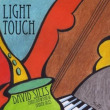 his own "It's All You" (his line on "It's You or No One"), he is unhurried and cogent. With pianist Chris Dawson and bassist Derek Oles, Sills applies his capacious tone and pliant imagination to pieces by a variety of composers including Horace Silver, Cole Porter, Hermeto Pascoal and Bill Evans. There are high points in moments of counterpoint between Sills and Dawson, an increasingly impressive pianist. Sills plays flute to great effect on Evans' minor blues "Interplay." Oles solos powerfully for one chorus on the piece. That's all he needed. This first CD on Sills' own label is a sleeper. It deserves attention.
his own "It's All You" (his line on "It's You or No One"), he is unhurried and cogent. With pianist Chris Dawson and bassist Derek Oles, Sills applies his capacious tone and pliant imagination to pieces by a variety of composers including Horace Silver, Cole Porter, Hermeto Pascoal and Bill Evans. There are high points in moments of counterpoint between Sills and Dawson, an increasingly impressive pianist. Sills plays flute to great effect on Evans' minor blues "Interplay." Oles solos powerfully for one chorus on the piece. That's all he needed. This first CD on Sills' own label is a sleeper. It deserves attention.
Oscar Peterson & The Bassists (OJC). One of the most unusual trio recordings of Oscar Peterson's career was of a performance at the 1977 Montreux Jazz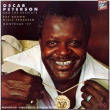 Festival in Switzerland. It is still in the OJC catalog. He appeared not with bass and drums or bass and guitar, but with two formidable bassists. Ray Brown's association with Peterson went back nearly 30 years to the beginning of the pianist's American career. The astonishing young Dane Niels-Henning Ørsted Pedersen was a more recent colleague. The three played a set that included memorable versions of "There is no Greater Love" and "Reunion Blues," but the piece de resistance was a "Sweet Georgia Brown" containing an unaccompanied Peterson chorus that someone cut out of the Montreux video, labeled the "Greatest piano solo ever" and posted on YouTube. I can imagine Oscar countering that claim by invoking Art Tatum. But here is that breathtaking solo in the context of the complete performance, allowing you to judge for yourself.
Festival in Switzerland. It is still in the OJC catalog. He appeared not with bass and drums or bass and guitar, but with two formidable bassists. Ray Brown's association with Peterson went back nearly 30 years to the beginning of the pianist's American career. The astonishing young Dane Niels-Henning Ørsted Pedersen was a more recent colleague. The three played a set that included memorable versions of "There is no Greater Love" and "Reunion Blues," but the piece de resistance was a "Sweet Georgia Brown" containing an unaccompanied Peterson chorus that someone cut out of the Montreux video, labeled the "Greatest piano solo ever" and posted on YouTube. I can imagine Oscar countering that claim by invoking Art Tatum. But here is that breathtaking solo in the context of the complete performance, allowing you to judge for yourself.
Hal Galper, E Pluribus Unum (Origin). You won't be hearing Galper on your favorite easy listening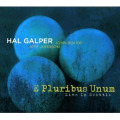 station. The past few years, the pianist has used sonic density, astringent harmonies, massive technique and powerful swing to build intricate edifices. Galper's music is demanding beyond even the muscular bebop he played when he was the pianist in Phil Woods' quintet. The experienced listener who brings an open mind will be drawn in by a story teller creating layers of meaning with expressed and implied allusions to shared musical
station. The past few years, the pianist has used sonic density, astringent harmonies, massive technique and powerful swing to build intricate edifices. Galper's music is demanding beyond even the muscular bebop he played when he was the pianist in Phil Woods' quintet. The experienced listener who brings an open mind will be drawn in by a story teller creating layers of meaning with expressed and implied allusions to shared musical 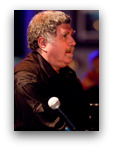 understanding. Bassist Jeff Johnson and drummer John Bishop, members of Galper's working trio, agree so thoroughly with his ethos that the three achieve the accord suggested by name of the album. Several hearings (recommended) disclose the depth of their relationship and interaction
understanding. Bassist Jeff Johnson and drummer John Bishop, members of Galper's working trio, agree so thoroughly with his ethos that the three achieve the accord suggested by name of the album. Several hearings (recommended) disclose the depth of their relationship and interaction
In Charlie Parker's "Constellation," the trio's unity coalesces around swirls of sound spinning out of "I Got Rhythm" harmonies and suggesting the subject of the piece's title. "How Deep is the Ocean" builds--and builds--and builds--on Irving Berlin's melody and chord changes, moving into realms of complexity that Berlin never imagined when he wrote the song in 1932. Duke Ellington's "Take the Coltrane" is as a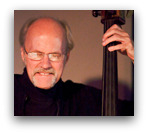 free as a blues can be and still be the blues. Of Galper's original compositions, the title of "Rapunzel's Luncheonette" stimulates nearly as many images as the piece itself. The modal energy in his left hand supports wild sorties by the right up and down the keyboard. If McCoy Tyner happens to hear the piece, I should imagine he'll be grinning.
free as a blues can be and still be the blues. Of Galper's original compositions, the title of "Rapunzel's Luncheonette" stimulates nearly as many images as the piece itself. The modal energy in his left hand supports wild sorties by the right up and down the keyboard. If McCoy Tyner happens to hear the piece, I should imagine he'll be grinning.
Dedicated to Michael Brecker, "Soliloquy" is the kind of ballad the late tenor saxophonist thrived on, blending lyricism, nostalgia and power. Johnson's solo is a high point of the 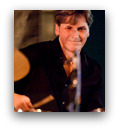 album. "Wandering Spirit," floating through a harmonic sequence that is less plain that it first seems, gathers intensity through Galper's solo, subsides during a superb Johnson solo, and wanders away on Bishop's cymbal splashes. "Invitation to Openness" suggests spontaneous mutual invention, with lines from the three musicians swimming and leaping together like dolphins at play.
album. "Wandering Spirit," floating through a harmonic sequence that is less plain that it first seems, gathers intensity through Galper's solo, subsides during a superb Johnson solo, and wanders away on Bishop's cymbal splashes. "Invitation to Openness" suggests spontaneous mutual invention, with lines from the three musicians swimming and leaping together like dolphins at play.
Occasionally, a Rifftides reader sends a message compelling enough that it demands posting not as a comment but as a full-fledged item. In the blog's five years, there have been few. Jeff Sultanof's recent recollection of Gene Lees was one. A few days later, we have Peter Kountz's tribute to Rob McConnell.
 Dr. Kountz is head of Philadelphia's Charter High School For Architecture + Design, an independent tuition-free public school that is the first of its kind in the United States. His background includes leadership of K-12 schools in Pittsburgh and Brooklyn and positions on the faculties of the University of Rochester and the University of Chicago, where he earned his PhD. A musician, writer and consultant, he also coaches professional musicians.
Dr. Kountz is head of Philadelphia's Charter High School For Architecture + Design, an independent tuition-free public school that is the first of its kind in the United States. His background includes leadership of K-12 schools in Pittsburgh and Brooklyn and positions on the faculties of the University of Rochester and the University of Chicago, where he earned his PhD. A musician, writer and consultant, he also coaches professional musicians.
On Rob McConnellBy Peter Kountz
I can't say that I knew him well or that we were real friends. If I knew Rob McConnell at all, I knew him as a brilliant artist and musician, whose gifts were often rivaled by his complicated personal qualities and his battles with the demons of self-deprecation. I followed RMcC's work for the last 25 years and I had the honor of producing in Pittsburgh in January of 1999, one of the last complete concerts the full Boss Brass did before RMcC downsized to the Tentet. Back to that concert in a moment.
The brilliance of Rob McConnell's artistry, musicianship, and craft was not so much his charisma as a band leader or his underappreciated proficient and inventive valve trombone playing, but rather what he was able to hear and imagine as a composer and arranger and how these "sound ideas" were put together for the Boss Brass and the Tentet, and accompanying artists like the Hi Lo's, Mel Tormé, or the Singers Unlimited.
There were other bands beside the Boss Brass, bands with marvelous sounds grounded in accessible melodies and harmonies, dressed in exciting arrangements and richly intricate rhythms, all with a delightful ease of listening. I am safe in saying, however, that there was never any band quite like the full Boss Brass with its additional brass (French Horn and sometimes tuba), woodwinds (clarinet, bass clarinet and flute) percussion (vibraphone, congas) and keyboards (organ); with its complex and daring arrangements, most with wry humor thrown in; with its extraordinary display of collective and individual virtuosity, with the power and precision of the ensemble itself; and withthe unfailing delight and swing that came through even in the recordings. So is there one recording that gives all this--and more--to the listener, you ask? Yes there is, I say, and it is the penultimate Boss Brass recording, Even Canadians Get the Blues (Concord Jazz). It is all there.
Apart from his family and his oldest friends, I am not certain anyone knows the full answer as to who Rob McConnell was, assuming there is one. Here, I want to offer some impressions of who and how he was, based on my encounters and experiences with RMcC. I was always struck with how kind and thoughtful he could be, not necessarily how kind he always was. His standards were very high, so high, in fact, that most music students (undergraduate and graduate) could not easily get to where he wanted them to be; he was not a natural teacher and did not really like the act of teaching, so his music became his teaching instrument. Life for him may have seemed to others simple and full of fun, but it was always far from that in reality. He really did love his family, though enduring personal relationships came with great difficulty for him and one never knew how or why he/she made it to the RMcC persona-non-grata list.
Like Duke Ellington, he composed and arranged for people he knew who were artist-musicians and players and who could meet every musical challenge he put forward. He could be as grumpy as he was thoughtful. He was his own worst enemy and his impatience with mediocrity was as intense as his full-blown intolerance of certain people and certain facts and realities in the business; he may have been a twin of Gene Lees. Rob McConnell loved being Canadian and he got the blues a lot but he had a great time composing, arranging, and playing the blues. He took himself a lot more seriously than most people realized because he worked so hard to keep everyone thinking the opposite, sometimes to the point of embarrassing himself. Mostly he liked who he was though it wasn't easy, especially when it came to being successful.
So now about that Pittsburgh concert and the lessons learned. A well-known physician and jazz musician whom I knew in Pittsburgh when I worked there died suddenly and my wife and I were asked to join a small group of friends and family to plan a public tribute to his work and his music. When it was decided to have a benefit concert in our friend's honor to create an endowment with The Pittsburgh Foundation to fund a scholarship for a deserving young jazz musician, I was given the task of choosing the artists and producing the concert. The "Friends Group" joined hands in sponsorship with the Pittsburgh Jazz Society and jazz impresario Tony Mowod of WDUQ-FM and we were on our way. I knew instantly that the concert should be by Rob McConnell and the Boss Brass. I went to work selling the idea. That wasn't as easy as it might appear. I bought CD's and gave copies to "The Friends" and, through the music it seems, I was given the green light. All this was before I had contacted Mr. Boss Brass himself. In those days of RMcC's pre-luddite tendencies, everything was done by letter fax, that is to say, the correspondent would write a letter and or a request, and then fax it to the McConnell home office which, to this day, I believe the saintly Margaret McConnell oversaw.
Without going back and reading the correspondence (all of which I have saved) I remember that my experience working with "His Tromboneness," which I happily and perhaps naively called him, was easy, efficient, warm, business-like and very professional. We agreed on the date (January 26, 1999), the fee, the venue, the logistics, the cause, and even part of the program set list, though I had been warned that no one ever suggested to the Great One that he consider a suggested program. Okay, I thought, I trust this guy. And I really did. And, as it turned out, he trusted me. I asked him to open the program with his arrangement of Loonis McGlohan's composition, "Songbird,"* and close the program with his arrangement of Gene Puerling's, "Nightfall."** Both of these arrangements are for winds only (no rhythm or keyboards) and both are fiercely difficult ensemble pieces in almost free rhythm, with no room for individual errors; every note for every part has to be right and fall in the right place at the right time.
His Tromboneness said, fine, we can do this. The bus arrived, I met it, and took things
from there. While making sure that everything was in order -the show began at 8:00pm--I stayed behind the scenes. Much to my surprise, RMcC asked me to work with him on the sound check, which I did, and he listened carefully to my comments and suggestions and, to my amazement, responded to each one. We served an early dinner to the artist-musicians (and that they were) and gave them all room to relax. I put the check in His Tromboneness's hands, and moved forward to show time.
The band walked on stage and we began on the dot at 8:00pm with "Songbird;" beautifully played, beautifully realized, and followed by a rich and full program. As I remember, there were at least 12 pieces on the set list (with introductions and comments from Mr. BB) and a generous intermission. RMcC used his final comments to thank the sold-out audience "for coming, for listening and for remembering Howard," the physician/musician we honored that night. Then came "Nightfall." Was there ever anything so beautiful, so perfectly played and so right? I don't think so. And as the band got on the bus after packing up and putting down a Canadian brewski or two, His Tromboneness said to me, "Peter, this was the best produced, best managed, and most fun Boss Brass concert ever and we will always remember it." As will I.
The Cheyenne Native Americans have a beautiful Prayer for the Dead: Go on into the Light and do not look back. We will take care of everything here. And, as "Nightfall" has come, so we will.
Rest in the Light, Your Royalness, and know how grateful we are for your life and music.
* "Songbird" -- heard on All in Good Time (Sea Breeze CD-SB-105)
** "Nightfall" --heard on Our 25th Year (Concord Jazz-CCD-4559)
Philadelphia
2-3 May 2010
In an auxiliary message, Peter Kountz added:
One important element for me in writing the piece is that there is likely to be very little extended recognition of RMcC on the American side, and in Canada he PO'd so many people, not many good folks are going to care. I want people to realize some things about this amazing, gruff artist-musician in our midst who just kept making extraordinary music.
...because everyone should listen to it now and then.
The first tenor saxophone solo is by Lester Young. The trumpet is Harry Edison. The second tenor solo is by Herchel Evans. Prez has the tag.
Apr 3 - Need a paper typed? Need a editor? -
Another significant Canadian contributor to jazz is gone. Barely more than a week after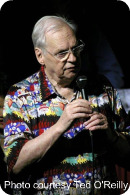 Gene Lees died comes news that Rob McConnell lost his long struggle with cancer Saturday in a Toronto hospital. A valve trombonist, arranger, composer and leader, McConnell made his Boss Brass one of the significant big bands of the latter part of the twentieth century and into the first decade of this one.
Gene Lees died comes news that Rob McConnell lost his long struggle with cancer Saturday in a Toronto hospital. A valve trombonist, arranger, composer and leader, McConnell made his Boss Brass one of the significant big bands of the latter part of the twentieth century and into the first decade of this one.
Here he is with the Boss Brass on a visit to the US west coast in 1981. Rob introduces the piece and soloists. "Jimmy" is pianist Jimmy Dale. Terry Clarke is the drummer, Don Thompson the bassist. A complete list of the band members runs at the end of the clip.
The Toronto radio station Jazz.FM91 has posted a biography, as well as news about the McConnell documentary that it will air and stream on the web this evening. To read a star.com obituary, go here.
Rob McConnell, RIP
A few years ago, Gene Lees and I fell into serious agreement. It happened in one of our long talks over a glass of wine, or two, at the big table just off the kitchen in his and Janet's house in Ojai. We were kicking around the peculiar effect that popular acceptance of an artist often has on the perception of critics and fellow musicians. We discussed the Modern Jazz Quartet, Cannonball Adderley, the Dave Brubeck Quartet and Diana Krall, all of whom during their struggle upward were lauded by writers and colleagues.
In each instance, when the musician began selling significant numbers of records and moved from subsistence work in clubs into the remunerative realm of the concert circuit, reviewers who wrote praise the year before suddenly detected compromised artistic standards. Among envious musicians, the logic seemed to go like this: if I haven't made it big and those people have, they must have sold out.
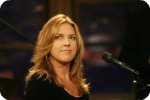 Diana Krall was the most recent example. She had rather quickly gone from moderate recognition to stardom. The predictable post-success sniping was underway, but Lees and I thought that her playing put her high in the second tier of current jazz pianists and that she might someday edge into the first rank. We agreed that her singing, always good, had improved in intonation, time feeling and maturity of expression. Attractiveness and the naturalness of her stage presence were adjuncts to her popularity, we said, not the cause of it. Salud! Then we probably went on to argue about something.
Diana Krall was the most recent example. She had rather quickly gone from moderate recognition to stardom. The predictable post-success sniping was underway, but Lees and I thought that her playing put her high in the second tier of current jazz pianists and that she might someday edge into the first rank. We agreed that her singing, always good, had improved in intonation, time feeling and maturity of expression. Attractiveness and the naturalness of her stage presence were adjuncts to her popularity, we said, not the cause of it. Salud! Then we probably went on to argue about something.
Not long after that, Gene met Ms. Krall and wrote about her in 1999 for Jazz Times. The piece was a character study. It was built on their conversations, the quotes arranged and set in the text in that incomparable Lees way. He makes the reader an eavesdropper, a technique light years beyond substituting transcribed verbatim interviews for writing. The narrative sections were straightforward, like this one:
She has a strong face, and when the stage lights hit it, it radiated, looking like a flower above her black pantsuit. She is an outstanding pianist. (Even if she grouses about what she considers a limited technique; but compared to what, Art Tatum?) She sits slightly sideways at the keyboard, to face the audience, as Nat Cole used to do; maybe she picked it up from his movies and TV shows. Again she got a standing ovation. Whether she likes it or not, she is the glamour girl of jazz. I just hope her singing success doesn't take her away from the piano, as it did Nat Cole.
It hasn't. To read the entire article, go here.
I thought about that conversation and that article the other day when one of those Jazz On The Tube e-mail links showed up. It turned out to be to a section of Ms. Krall's 2001 Live in Paris DVD, which I had never seen. She is with a large orchestra conducted by Alan Broadbent. John Clayton is the bassist, Jeff Hamilton the drummer, Anthony Wilson her regular guitarist, and we get a couple of glimpses of the marvelous John Pisano on acoustic guitar. If this is selling out, I'll take it.
A man named Paul Sonnenberg has posted a medley of songs with Gene Lees' lyrics. If you go here, you'll learn as much about Mr. Sonnenberg as I know. If you watch the video below, you'll see and hear him sing the songs, largely in tune, with a feel for the Brazilian samba idiom and with, for the most part, the correct English lyrics. In "Quiet Night of Quiet Stars," it should be, "...how lovely," not "...so lovely," but that's quibbling. Here's Paul Sonnenberg doing nice work.
Rifftides is going to move on from Gene Lees, at least for the moment, and on to other matters. My plan for next time is to catch up with a few recent CDs.
Tributes to Gene Lees continue, for good reason. A line from Longfellow applies: "Dead he is not, but departed - for the artist never dies."
Terry Teachout remembers Gene in today's Wall Street Journal:
Had Gene been born sooner, he would surely have been as famous and successful as the top songwriters of the '30s and '40s. But he came along after the cultural tide of jazz had started to ebb, and by the time his songs were making their mark, rock 'n' roll was in the process of replacing jazz as the lingua franca of American popular music.
And
Part of what made Gene's essays so valuable was that he wrote them not as a coolly objective observer but as a man immersed in the culture that he chronicled. More often than not, his subjects were his friends, and he had seen them at their best and, on occasion, their worst.
To read all of Terry's "Sightings" column, go here.
Following Gene Lees' passing, the Canadian tenor saxophonist, pianist, composer, arranger and educator Phil Dwyer sent a story about how he acquired one of Gene's books.
In the spring of 1990, I was playing in New York, at a club call Visione's (in the Village) with David Friesen and Alan Jones. It was the middle of a long (seven.weeks) tour. It would ultimately be the last tour for the group, which had formed in 1987. For me, the New York stop was a highlight not only because it was New York, but also because my new girlfriend was traveling down from Toronto to meet up with me for the two days we were there. The tour had been a little tense, so it was great to have someone else to talk to for a few days!
Anyway, we're playing at Visione's and I popped across the street on the break to grab a slice, I don't remember which place (50/50 chance it was some kind of "Ray's") and was standing on the street eating it when this twitchy fellow approached me...."Hey, man, where did you get that pizza?" Bear in mind I am standing about 20 feet from the pizza store at this point....."Man, I'm starving, I've been out selling these books all day, can you spare a couple of dollars for a brother to get a slice?"
"Books?" says I, "What books do you have for sale?"
He opened the bag up, and I could see maybe 7 or 8 copies of The Will To Swing.
"Sell me a book" I said, vaguely aware that I was probably skating over some kind of moral blue-line at this stage.* "How much?"
"Ten dollars, brother"
I only had a twenty, so I passed him the twenty, and he reached into his pocket, where he had a roll of bills certainly more substantial than I did. He peeled off a ten for my change and passed it over with a sparkling new copy of the book. By this time I'm starting to feel a little weird about the whole thing, the books were almost certainly "hot", I didn't know Gene at the time but had several mutual friends, etc, but it all went down so fast and completely out of the blue that I was mostly thinking about what a great deal I was getting on this book which I had been hoping to get (I rank myself as a 10/10 when it comes to being an Oscar fan). Anyway, the deal was done and it was time to head back in for the second set.
As I turned to cross the street and return to Visione's, the book guy stopped me......."Hey man, what about the couple of dollars for the pizza?"
Too weird.
*Hockey metaphor; not sure if that translates
AJ Ads
AJ Blogs
AJBlogCentral | rssculture
Terry Teachout on the arts in New York City
Andrew Taylor on the business of arts & culture
rock culture approximately
Laura Collins-Hughes on arts, culture and coverage
Richard Kessler on arts education
Douglas McLennan's blog
Dalouge Smith advocates for the Arts
Art from the American Outback
Chloe Veltman on how culture will save the world
For immediate release: the arts are marketable
No genre is the new genre
David Jays on theatre and dance
Paul Levy measures the Angles
Judith H. Dobrzynski on Culture
John Rockwell on the arts
innovations and impediments in not-for-profit arts
Jan Herman - arts, media & culture with 'tude
dance
Apollinaire Scherr talks about dance
Tobi Tobias on dance et al...
jazz
Howard Mandel's freelance Urban Improvisation
Focus on New Orleans. Jazz and Other Sounds
Doug Ramsey on Jazz and other matters...
media
Jeff Weinstein's Cultural Mixology
Martha Bayles on Film...
classical music
Fresh ideas on building arts communities
Greg Sandow performs a book-in-progress
Harvey Sachs on music, and various digressions
Bruce Brubaker on all things Piano
Kyle Gann on music after the fact
Greg Sandow on the future of Classical Music
Norman Lebrecht on Shifting Sound Worlds
Joe Horowitz on music
publishing
Jerome Weeks on Books
Scott McLemee on books, ideas & trash-culture ephemera
theatre
Wendy Rosenfield: covering drama, onstage and off
visual
Public Art, Public Space
Regina Hackett takes her Art To Go
John Perreault's art diary
Lee Rosenbaum's Cultural Commentary
